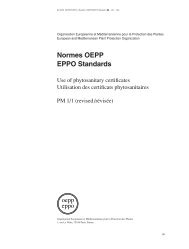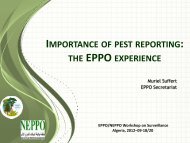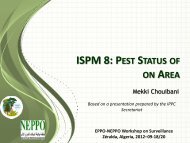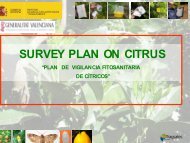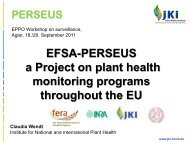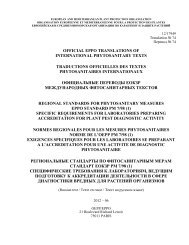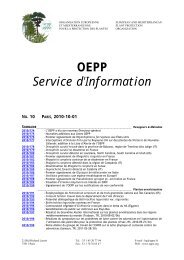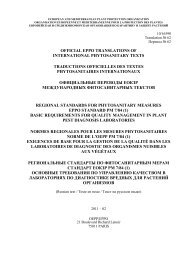EPPO Reporting Service - Lists of EPPO Standards - European and ...
EPPO Reporting Service - Lists of EPPO Standards - European and ...
EPPO Reporting Service - Lists of EPPO Standards - European and ...
You also want an ePaper? Increase the reach of your titles
YUMPU automatically turns print PDFs into web optimized ePapers that Google loves.
<strong>EPPO</strong> <strong>Reporting</strong> <strong>Service</strong> – Pests & Diseases<br />
2011/041 Glycaspis brimblecombei occurs in Sardinia, Italy<br />
In Italy, Glycaspis brimblecombei (Hemiptera: Psyllidae – formerly <strong>EPPO</strong> Alert List) was<br />
detected for the first time in March 2010 on the foliage <strong>of</strong> Eucalyptus camaldulensis trees<br />
in several provinces <strong>of</strong> Campania (see <strong>EPPO</strong> RS 2010/186 <strong>and</strong> article from Laudonia &<br />
Garonna on the <strong>EPPO</strong> website). The NPPO <strong>of</strong> Italy recently informed the <strong>EPPO</strong> Secretariat<br />
that the pest has also been found in Sardinia on trees <strong>of</strong> E. camaldulensis. Surveys are<br />
being carried out in Sardinia to delimit the extent <strong>of</strong> the infestation.<br />
The situation <strong>of</strong> Glycaspis brimblecombei in Italy can be described as follows: Present,<br />
found in Campania <strong>and</strong> Sardinia on Eucalyptus camaldulensis.<br />
Source: NPPO <strong>of</strong> Italy (2010-12).<br />
<strong>EPPO</strong> Website<br />
Laudonia S & Garonna AP (2011) First record <strong>of</strong> the redgum lerp psyllid, Glycaspis<br />
brimblecombei, a new exotic pest <strong>of</strong> Eucalyptus camaldulensis in Southern Italy.<br />
http://www.eppo.org/QUARANTINE/Glycaspis_brimblecombei_IT/Glycaspis_brimblecombei_IT.htm<br />
Additional key words: detailed record Computer codes: GLYSBR, IT<br />
2011/042 New data on quarantine pests <strong>and</strong> pests <strong>of</strong> the <strong>EPPO</strong> Alert List<br />
By searching through the literature, the <strong>EPPO</strong> Secretariat has extracted the following new<br />
data concerning quarantine pests <strong>and</strong> pests included on the <strong>EPPO</strong> Alert List. The situation<br />
<strong>of</strong> the pest concerned is indicated in bold, using the terms <strong>of</strong> ISPM no. 8.<br />
� New records<br />
Arabis mosaic virus (Nepovirus, ArMV - EU Annexes) was reported for the first time in Spain<br />
in 2007. ArMV was detected on grapevine in Galicia (in Val de Salnés on Rias Baixas<br />
appellation) <strong>and</strong> in Pais Vasco (in Barriobusto on appellation Rioja). In the infected<br />
vineyard in Galicia, the presence <strong>of</strong> the nematode vector, Xiphinema diversicaudatum,<br />
was detected in the soil. A preliminary survey showed that the virus incidence is low <strong>and</strong><br />
that only a minimal spread occurred. In Spain as a whole, ArMV seems to be rare <strong>and</strong><br />
associated with the Atlantic biogeographic region (Abelleira et al., 2010).<br />
Acizzia jamatonica (Hemiptera: Psyllidae – formerly <strong>EPPO</strong> Alert List) was detected for the<br />
first time in Greece. In August 2009, damage caused by this psyllid was noticed in Albizia<br />
julibrissin trees in the centre <strong>of</strong> Thessaloniki (Pásztor et al., 2010). In 2009, the presence<br />
<strong>of</strong> A. jamatonica has also been reported from Serbia (Vétek et al., 2009), <strong>and</strong> Bulgaria in<br />
the city <strong>of</strong> Nessebar (Vétek <strong>and</strong> Rédei, 2009).<br />
Cowpea mild mottle virus (Carlavirus – EU Annexes) was first found in Southern Iran<br />
(Khorestan province) during the 2006 <strong>and</strong> 2007 soybean growing seasons (Tavassoli et al.,<br />
2009). Present, first found in 2006 on soybean in Khorestan province.<br />
In Iran, almond witches’ broom disease has recently been observed in the centre <strong>and</strong> south<br />
<strong>of</strong> the country. Trees showing different symptoms (yellowing <strong>and</strong> little leaf) were also<br />
observed. Studies were conducted from 2001 to 2005 <strong>and</strong> showed that several<br />
phytoplasmas could be detected in diseased almond trees. They were closely related to<br />
‘C<strong>and</strong>idatus Phytoplasma phoenicium’ (associated with almond witches’ broom in Lebanon<br />
12




